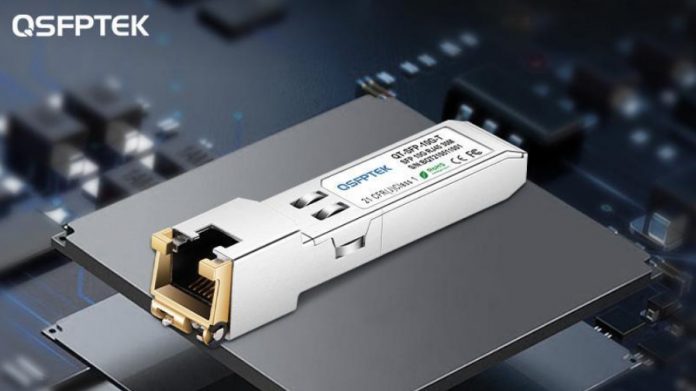10GBASE-T Test Items
802.3an lists the measurement items required for 10GBASE-T compliance measurement, including seven single-item measurements, namely Maximum Output Droop, Transmitter Clock Frequency, and Transmitter Jitter- Master Mode, Transmitter Timing Jitter-Slave Mode, Transmission Linearity, Transmitter Power Spectral Density (PSD) and Power Level, and Return Loss.
10GBASE-T test Purpose and Method
The maximum output drop needs to configure the device under test (DUT) to enter test mode 6. The DUT sends the following data loops on the four pairs of transmission links at the same time {consecutive 128 “+16” symbols, 128 consecutive “-16” symbols …}, forming a low frequency square wave signal of 3.125MHZ. What needs to be measured is from the 10th to the 90th ns from the zero-crossing point of the square wave, and the voltage drop is required not to exceed 10%. The main purpose of this test is to ensure that the drop of the amplitude is still within the allowable range under the condition of continuous high repetition of the Symbol, and there will be no misjudgment of the Symbol.
The clock frequency of the sender needs to configure the device under test to enter test mode 2, and the device under test sends the following data loops on the four pairs of transmission links at the same time {2 “+16” Symbol, 2 “-16” Symbol…}, forming A 200MHZ pseudo clock. To measure the frequency of this clock, the 10GBASE-T specification requires the result to be within 50ppm of 200MHZ.
Transmitter Jitter – Master Mode This test is very similar to the Transmitter Clock Frequency test, and also enters Test Mode 2. The 10GBASE-T specification requires that the RMS value of jitter should be within 5.5ps. It is worth mentioning that due to the very high requirements of jitter measurement, the association recommends using an intermediate frequency filter with an intermediate frequency of 200MHZ and a bandwidth of 2MHZ to filter out the influence of noise and clutter unrelated to the test. In LeCroy’s automated measurement solutions, software filters can be selected for filtering.
Transmitter jitter-slave mode is different from master mode. Jitter test in slave mode requires a link partner to assist in the measurement, that is, to interconnect with another device that supports 10GBASE-T. Link Partner enters test mode 1, and sends pseudo-random code (PRBS33) to three pairs of data links A, B, and C at the same time in master mode. DUT enters test mode 3. After receiving the signal from Link Partner, it recovers a 200MHZ clock and sends it to the D data pair in a data loop {2 “+16” Symbol, 2 “-16Symbol…} Out. What needs to be measured is the jitter of the pseudo clock on the D data pair, and the 10GBASE-T specification still requires that the jitter RMS value is within 5.5ps. This measurement is also recommended to use an IF filter for filtering.
The transmission linearity needs to configure the DUT to enter the test mode 4, and the DUT sends a set of dual tone signals (Dual Tone) to the four pairs of transmission links at the same time, that is, two sine wave signals with very close frequencies and equal amplitudes. Transmission linearity is measured by spurious-free dynamic range (SFDR), which is the difference between the RMS amplitude of the carrier frequency (maximum signal component) and the sub-maximum noise component or harmonic distortion component (only considering harmonic components between 1MHz and 400MHz). Ratio of RMS values. The 10GBASE-T specification requires that the SFDR for this test should meet:
SFDR≥2.5 + min{52, 58–20×log10(f/25)} In this test, five groups of two-tone signals with different frequencies need to be tested respectively. Please refer to Table 1 for the frequency of the two-tone signal and the requirements of the 10GBASE-T specification. Considering that jitter and distortion are inevitably generated after the signal is transmitted over a long distance, the frequency of the signal will fluctuate within a small range. Each group of two-tone signals simulates the worst jitter condition. If the energy of the harmonic distortion components generated in this case is guaranteed to be small enough, it will not affect the signals of other frequencies.
The power spectral density and power values need to configure the DUT to enter test mode 5, the normal operation mode. The transmitter power needs to be between 3.2dBm and 5.2dBm. Its power spectral density (under 100ohm load) needs to meet the upper and lower limits specified in the protocol. The protocol provisions are shown in Figure 1. The measured case waveform of LeCroy’s test plan is shown in Figure 2, where the red waveform is the spectrogram, the green waveform is the power spectral density, and the white lines are the upper and lower limits of the power spectral density.
The return loss test still follows the test method before the Ethernet series protocol. A signal source sends out a frequency sweep signal, and the two channels of the oscilloscope are used to detect the incident waveform and the reflected waveform respectively, and calculate the return loss. It’s just that 10GBASE-T puts forward higher requirements on the ability of the signal source, and needs to be able to send out a frequency sweep signal up to 500MHZ. Alternatively, this measurement can also be done with a network analyzer.
QSFPTEK 10GBASE-T electrical port SFP+ modules have undergone the above strict testing process, and the product performance is guaranteed. Bulk purchases are welcome.


































